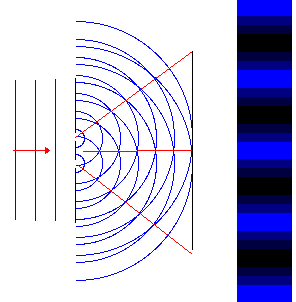
When the electron reaches the final screen (i.e., the projection screen), then if a degree of freedom was introduced, some physical manifestation of that degree of freedom must occur (hence one sees an interference pattern), but if no such degree of freedom was introduced the electron remains in a known state and so no interference pattern is seen. If such a measurement is taken, no such degree of freedom is introduced, because the measurement removes the ambiguity of which slit the electron could have passed through. If no measurement is taken to determine which slit the electron went through, a degree of freedom is introduced at that point. If one sends a single electron in a known physical state toward the screen with the two slits, by definition of a state that electron has no physical degrees of freedom before it reaches the slit-screen, In other words, the state of the electron is a known quantity initially. The physical degrees of freedom, namely the characteristic minimum number of variables needed to fully describe the physical situation, provide such an explanation. If then the wave particle duality is not useful in and of itself for understanding the results of the double-slit experiment, at least by assumption (again for the sake of argument), one needs a system by which to explain the results in terms which are well defined and without needing to worry about how an electron can be a wave, a particle or simultaneously both. After all, such a duality merely gives a name to the underlying observation that electrons and similar quantum particles have properties both of a wave and of a particle and that those properties will manifest themselves in different types of interactions that is the definition of a wave particle duality. Ģ) The proposed explanation simply replaces what are considered as ill defined terms with new terms namely a principle of form and the notion of Kevutsa.įor the sake of argument, one accepts the point of view that reference to a wave particle duality is not especially useful in understanding the results of the double-slit experiment. The discussion in proposes a Kevutsa or group interpretation of the double-slit experiment intended as an improvement on previous explanations which are claimed to have used “unclear terms”.įurther, in the interpretation depends on two proposed principles, an “equivalence of form” and “the particles connection to other particles, effectively functioning as a group.” The two most noticeable problems with the proposed explanation provided in are as follows:ġ) A group-based and hence effectively multi-particle explanation is difficult to justify for a physical phenomenon which can be observed in a single particle situation as can the self-interference characteristic of the double slit experiment. Perhaps the most recent such explanation is that proposed by Orion and Laitman to which the current discussion serves as a specific response. Various explanations have been proposed, but many of these explanations still regard this result as mysterious to varying degrees. When such a measurement is taken however, no interference pattern is observed. When no measurement is taken to determine through which slit the electron passes, an interference pattern is observed on the second screen.

An electron source projects electrons onto a screen with a double slit, through which an electron is then projected onto a second screen.

The famous double-slit experiment involves either the observation or non-observation of an interference pattern in two physical situations which differ only by whether a certain measurement is not or is taken respectively. By using physical degrees of freedom and the application of Hamilton’s principle, we obtain a single particle explanation of the double-slit experiment in terms of properties and via methods which apply equally in a quantum and a classical regime. Explanation in refers to properties of groups of particles, even though the double-slit experiment’s results should address only to a single particle. In response to Orion and Laitman’s explanation of the classic double-slit experiment of quantum mechanics, we propose an alternate explanation of that experiment by treating physical degrees of freedom as a conserved physical quantity, instead of referring to “vague terms” used in previous explanations,, that are not broadly applicable. Keywords: Hamilton’s principle, Single particle, Degrees of Freedom

1Jacob Blaustein Institutes for Desert Research, Ben-Gurion University of the Negev, Be’er Sheva, IsraelĢDepartment of Mechanical Engineering, Ben-Gurion University of the Negev, Be’er Sheva, IsraelĮ-mail: Novemrevised Decemaccepted December 13, 2010


 0 kommentar(er)
0 kommentar(er)
